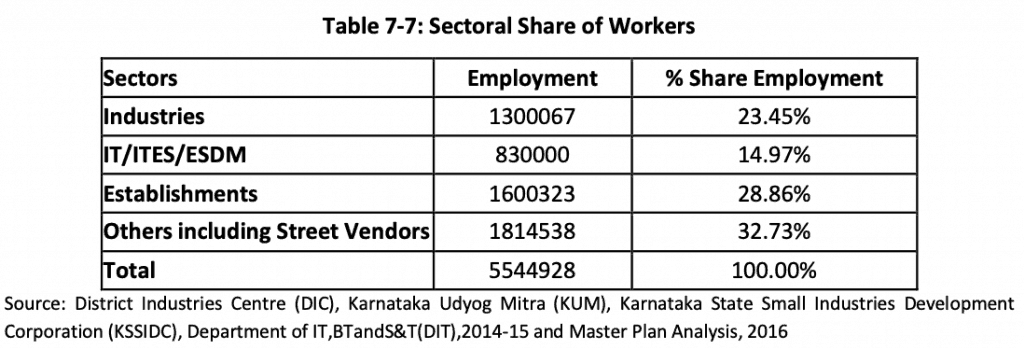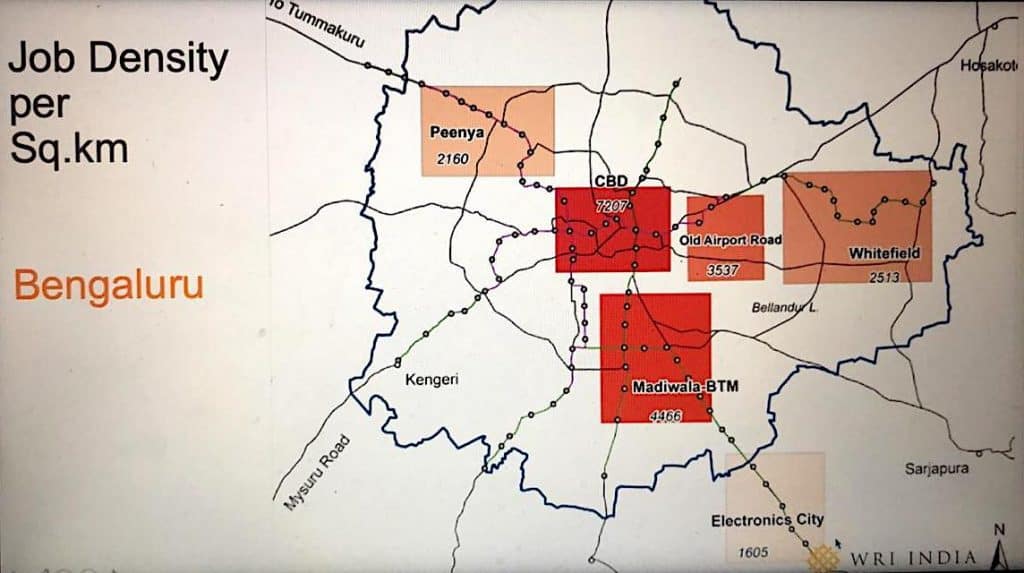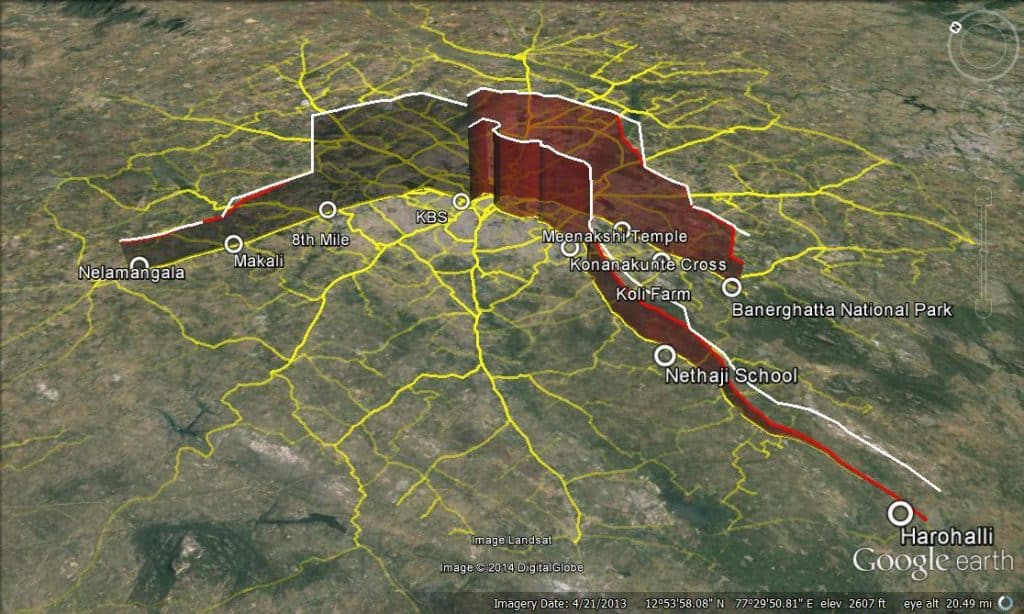Once the lockdown lifts, how do we facilitate Bengalureans’ travel across the city?
With the economy coming to a complete standstill due to the lockdown, transport needs as well as options have temporarily reduced to almost nothing. While several companies in the IT and services industry are looking at work-from-home as an option going forward, that will not be the same with manufacturing, bio-technology and establishment sectors.
However, if you look at the employment distribution industries, establishments and street vendors account for about 85% of the total employment in the city.
The big question is once the city opens how do we facilitate their travel?

Another interesting data point is the job density in the city. The map below shows the job densities in different parts of the city. The major clusters being Peenya, CBD, Old Airport Road, Whitefield, Madiwala-BTM and Electronic City. I would also add Kengeri-Bidadi to this list.
To begin with the Government of Karnataka can think of opening up these areas and could experiment with Peenya, Bidadi and Old Airport Road after ensuring these are not within the containment zones or hotspots.

One more data point is the distribution of trips according to mode of travel as presented in the figure below. Public transport trips (bus, minibus, school bus, chartered bus and metro) account for 32% of the total trips.
The challenge for the city is to facilitate safe travel in public transport modes and while walking.
It will be easy to follow social distancing norms while using own vehicles and probably with shared vehicles as well. In shared vehicles-car, taxis and autos allowing only one person in the back seat would probably be the new norm. The biggest challenge will be to handle the public transport services.
Specifically, BMTC services, the backbone of mobility in Bengaluru, will be of utmost importance as they carried almost 4 million daily trips pre-Covid.

BMTC’s routes have evolved along the major arterials known as the BIG-10. The figure shows the total number of trips along different sections of a corridor. The variation in boarding and alighting along the corridor will help in rationalising the routes to major destinations.
For example, the movement along Peenya Corridor is very clearly seen- three major points along the corridor are 8th mile, Makali and Nelamangala.
The approach to open up the corridors along the employment zones can be calculated based on the following methodology:
Demand Estimation:
- The number of total passengers along a specific BIG-10 corridor can be easily calculated based on the route level data that is available along the corridors. For example, a BIG 10 corridor carries anywhere between 200,000-300,000 trips. For the purpose of our calculations we are considering 200,000 passengers.
- From the table below we can see that about 65% of the trips are employment trips in BMTC although it will vary corridor to corridor but is a good starting point.
| Trip Purpose | Percentage (%) |
| Service | 49.1 |
| Business | 15.7 |
| Education | 11.8 |
| Social | 6.0 |
| Others | 17.4 |
- Due to gradual opening in the very first month after lock down assume only 30% of these trips will happen (dependent upon the number of employees that are allowed to travel to work)
Passenger Demand along the corridor
= Number of passenger trips along the corridor x Percentage of employment-related trips x Percentage of trips that are allowed in the immediate future
= 200,000 x 65% x 30%
= 39,000 (approx)
Supply estimation:
- Maximum possible occupancy in a bus under social distancing conditions is about 20-25
- Pre- Covid,
Passenger Kilometres
= Passenger trips (/day/bus carried out by BMTC) x Average trip length of a passenger trip (10kms)
= 800 x 10
= 8000
Peak load in the bus = 75 passengers including sitting and standing
Ratio of overall number of people carried to the peak load experienced on a normal day in BMTC = 800/75= 10.6 (approximately)
- Post Covid,
New Supply (Number of passengers carried /day/bus)
= New Occupancy x Carrying Ratio
= 25 x 10.6
= 266
Number of buses required along the corridor
= # of trips along the corridor / new supply per bus
= 39000 / 266
= 146 bus trips to be operated
This can be fine-tuned to peak periods in the morning and evening and accordingly frequency of services can be determined. It is recommended to run trunk only services along the corridor without adding much feeder services. It will be good to begin with this approach along 3-4 employment corridors (non-IT)
BMTC can also consider contracting buses to private manufacturing industry clusters to run as per their needs.
In addition, some measures like digital payments, ensuring safety of the crew, usage of masks, waiting at bus stops all need to be implemented. However, the financial situation of BMTC would be a big challenge post the lockdown. BMTC would also become an essential service for taking people to jobs – a big priority for all of us. Therefore, the Government of Karnataka and BBMP need to support BMTC in funding the revenue gaps to be able to pay their employees.
[Pawan Mulukutla has written this article in his individual capacity. Parthu Balina also contributed to this article with data support.]
Nice insights and research. Hope this is used by BMTC beneficially
The daily trip visualization shows large step changes at specific points. That means a large amount of traffic comes from lateral routes and merges here. BMTC must plan for high-frequency shuttles on these lateral routes. Otherwise those people will use their personal vehicles and congest the roads.
The ticketing itself would pass infection via conductor. Therefore the ticketing should be eliminated for at least one month. Let people prepay and enter the bus, or drop change in a locked box (fair price for their ticket). At the end of the shift, it is easy to decontaminate the money using UV light and hot air (>40 C) to kill the virus.
BMTC must demonstrate to the public that all buses are decontaminated after each trip. Otherwise, people won’t trust the BMTC buses, and tend to use their own vehicles.
BMTC must also declare emphatically that they are arranging for a far higher frequency of buses, to compensate for the lower occupancy allowed in each bus. BMTC must also abandon plying buses on long routes and opt for high-frequency shuttles beween hubs. That way people won’t scramble for their buses, and wait for the next one. The long-distance travelers will have to change buses, but most travelers will get the benfit of a single-bus trip.
BMTC must stop doing their usual ABC analysis for a couple of months, to kick-start the economy without congesting the roads. This loss must be part of the economic package offered by GoK/GoI.
BMTC also can have discussion with tech parks and industrial estates to understand where their employees are coming from, and arrange for buses till the nearest hub.
BMTC makes drivers and conductors to clean bus every night. Observed with KSRTC. While it is important, please Realize that you are adding this for every trip. May be BMTC need to charge passengers for expense towards decontamination after each trip
No this cleaning is only of the high-contact surface, not sweeping of the whole bus.
That means sanitizing of rods at the back of every seat and the rods fixed to the ceiling; where the passengers touch.
Secondly, this exercise needs to be highly visible, so that passengers develop confidence that it is safe to ride a bus.
Well, after lockdown, when things open, social distancing will be norm, for safety, better to wear Mask,
Waiting time will increase, if all public transport follows norm, that any vehicle should have minimum people, not like earlier cramped, especially in BMTC bus in two seater one person is ideal, follow distance or q while boarding and deboarding ( that way in Mumbai, everyone follows line)
Remove alternative seats from buses ,make passengers to sit alone in the seat. That’s conductor job.. make more trips as possible ,since fuel prices are fallen steeply , don’t charge state tax on fuel for running govt buses,it’s double benifit.allow passengers into buses who have masks ..in case they don’t have ,sell them one,they won’t throw it cuz they brought it..
Nice research and analysis. This Question was bothering me .. how those dependent on Public Transport can get back to work if Public Transport is suspended, discouraged, and how can economic activity possibly revive then ? But then how social distancing is possible in Public Transport ? .. So very happy to see someone address this issue and methodically trying to untangle the knots and show an optimum way forward.
Few thoughts:
As most of the comments include social distancing in bus, I personally feel this may not be possible with an overcrowded city like Bengaluru. During peak hours, even with laws and regulations in force besides conductor/drivers advicing, this will not be followed.
Making one person sitting in a single seat can be changed instead to align the seat to the sideways with a gap in seat between each. This will help gain space for standing where there can be marked spots to stand.
Driver should not stop if all those marked spots are filled up. As well there should be thermal check (like how it is happening in UK) before taking a person into the bus.
For ticketing, we can use a scan and pay desk near the doors and windows to help people scan and pay. For those with currency, dropping them into a drop box is viable.
In case of using 4 wheelers and having a rule of only 2 can travel, makes it a horrible life for those with their family of 3 or 4. This law may need relaxation with masks, sanitizer kept in visibility area of each car.
Sir/Madam , this covid-19 period is a difficult situation and testing time for all,but we all should show courage and because all has doubt in their mind and confused .so day by day public will come forward and uses bmtc buses and state government should lift or extend buses movement atleast upto 10 p m, because in banglore reaching through bus takes time (mostly employees etc moving long distance s)